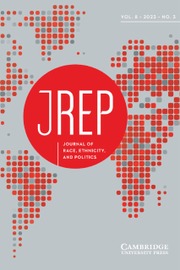No CrossRef data available.
Article contents
Race- and Class-Based Messaging and Anti-Carceral Policy Support
Published online by Cambridge University Press: 11 November 2025
Abstract
Strategic messaging can be used to build support for racial equity policies, but most research has found that linking issues to race is ineffective. What if using strategic messages to increase support for racial equity policies is not simply a matter of whether racial appeals are present in a message, but how they are framed? Evidence from an original survey experiment conducted among a highly diverse group of 2,320 randomly sampled voters in Los Angeles County demonstrates that the most effective messages are those that discuss both race and class—with distinct outcomes on message favorability and anti-carceral policy support. In addition, we find the effect is moderated by ethnoracial identity, racial resentment, and personal contact with the criminal legal system. Our findings suggest that how racial appeals are framed—not simply whether racial frames are present—is important in shaping the impact of a message; they also highlight the need for more research innovation with a variety of ways to link issues to racial inequality with the aim of building support for racial equity policies.
Information
- Type
- Research Article
- Information
- Copyright
- © The Author(s), 2025. Published by Cambridge University Press on behalf of the Race, Ethnicity, and Politics Section of the American Political Science Association

